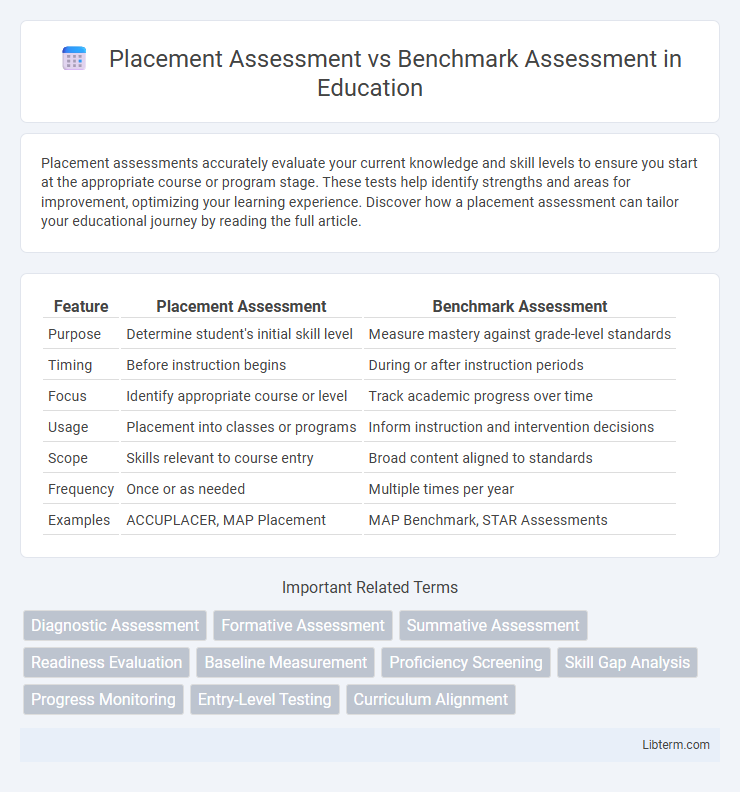Placement assessments accurately evaluate your current knowledge and skill levels to ensure you start at the appropriate course or program stage. These tests help identify strengths and areas for improvement, optimizing your learning experience. Discover how a placement assessment can tailor your educational journey by reading the full article.
Table of Comparison
| Feature | Placement Assessment | Benchmark Assessment |
|---|---|---|
| Purpose | Determine student's initial skill level | Measure mastery against grade-level standards |
| Timing | Before instruction begins | During or after instruction periods |
| Focus | Identify appropriate course or level | Track academic progress over time |
| Usage | Placement into classes or programs | Inform instruction and intervention decisions |
| Scope | Skills relevant to course entry | Broad content aligned to standards |
| Frequency | Once or as needed | Multiple times per year |
| Examples | ACCUPLACER, MAP Placement | MAP Benchmark, STAR Assessments |
Introduction to Placement and Benchmark Assessments
Placement assessments evaluate a student's current knowledge and skills to determine the most appropriate starting point in a course or program, ensuring tailored instruction and effective learning paths. Benchmark assessments periodically measure students' progress against specific standards or performance goals throughout the academic year, guiding instructional adjustments and promoting continuous improvement. Both assessments serve distinct roles in education by providing critical data for personalized learning and monitoring achievement growth.
Defining Placement Assessment
Placement Assessment evaluates a student's current knowledge and skills to determine the most appropriate level or course for instruction, ensuring personalized learning paths and preventing skill gaps. Unlike Benchmark Assessments, which measure student progress against set standards at specific intervals, Placement Assessments are administered before instruction begins to guide initial course placement. These assessments help educators match students with content that aligns accurately with their abilities for optimized learning outcomes.
Defining Benchmark Assessment
Benchmark assessment measures student performance against established standards at specific points during the academic year, providing actionable data to track progress and guide instructional decisions. Unlike placement assessments, which determine a student's initial course level, benchmark assessments monitor ongoing achievement to identify learning gaps and inform targeted interventions. Schools use benchmark assessments to ensure students meet grade-level expectations and improve overall academic outcomes.
Key Differences Between Placement and Benchmark Assessments
Placement assessments determine a student's initial skill level to assign appropriate learning materials or courses, focusing on individual proficiency and readiness. Benchmark assessments measure students' progress and performance against specific standards or grade-level expectations at set intervals. The key difference lies in placement assessments guiding entry points in instruction, while benchmark assessments monitor ongoing academic growth and effectiveness of teaching strategies.
Purposes and Goals of Placement Assessments
Placement assessments are designed to evaluate a learner's current skill level to determine the most appropriate starting point in a course or program, ensuring personalized and effective instruction. These assessments focus on identifying strengths and weaknesses to optimize learning paths and prevent students from repeating content they have already mastered. Unlike benchmark assessments, which measure progress over time, placement assessments primarily aim to guide initial course placement and support tailored educational planning.
Purposes and Goals of Benchmark Assessments
Benchmark assessments primarily aim to monitor student progress and inform instructional adjustments by measuring performance against established standards at multiple points during the academic year. These assessments help educators identify learning gaps, track growth, and ensure students are on track to meet grade-level expectations, facilitating data-driven decision-making. Unlike placement assessments, which determine a student's entry point into a course or program, benchmark assessments focus on ongoing evaluation to enhance teaching effectiveness and improve learning outcomes.
Benefits of Placement Assessments in Education
Placement assessments provide educators with precise insights into students' current knowledge and skill levels, enabling tailored instruction that meets individual learning needs. These assessments help optimize class composition by grouping students according to proficiency, enhancing targeted teaching and improving overall academic outcomes. By accurately identifying areas of strength and weakness, placement assessments minimize gaps in learning and support efficient progression through the curriculum.
Advantages of Benchmark Assessments for Student Progress
Benchmark assessments offer regular and timely data that helps educators monitor student progress throughout the academic year, enabling early identification of learning gaps. These assessments support data-driven instruction by providing detailed insights into student performance, allowing tailored interventions to improve educational outcomes. Benchmark assessments foster continuous improvement and accountability, promoting a proactive approach to student success rather than a single point-in-time evaluation like placement assessments.
Choosing the Right Assessment Strategy
Selecting the right assessment strategy depends on the specific goals of evaluating student learning. Placement assessments determine individual entry-level skills to tailor instruction, while benchmark assessments monitor progress and predict outcomes throughout a course or school year. Understanding the purpose of each helps educators implement the most effective tool for guiding instruction and improving student performance.
Conclusion: Placement Assessment vs Benchmark Assessment
Placement assessments determine a student's appropriate starting level in a course based on current knowledge, ensuring targeted instruction from the outset. Benchmark assessments measure student progress and mastery throughout the academic year, providing data to guide instructional adjustments. Both assessments play crucial roles in optimizing learning outcomes, with placement focusing on initial positioning and benchmarks tracking ongoing growth.
Placement Assessment Infographic

 libterm.com
libterm.com